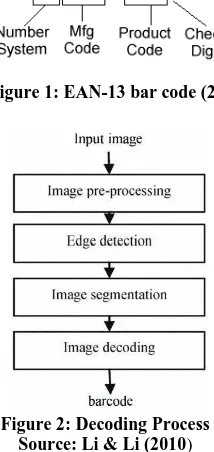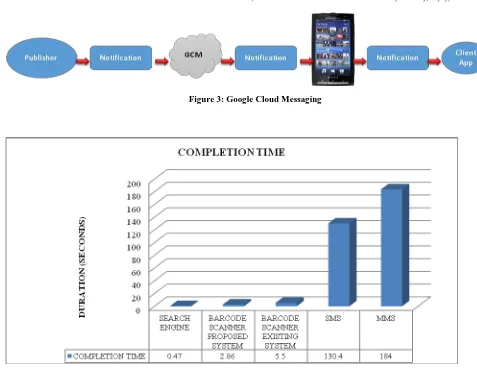International Symposium on Research in Innovation and Sustainability 2014 (ISoRIS ’14) 15-16 October 2014, Malacca, Malaysia Specia issue
Sci.Int.(Lahore),26(5),1751-1754,2014 ISSN 1013-5316; CODEN: SINTE 8 1751
HALAL BARCODE SCANNER PROTOTYPE IN ANDROID USING CLIENT
SIDE PROCESSING WITH JSON TECHNOLOGY
Noor Munirah binti Marzuki1, Tuty Asmawaty Abdul Kadir2 , A.S. Shibghatullah3
1,3
Optimization, Modelling, Analysis, Simulation and Scheduling (OptiMASS) Research Group, Fakulti Teknologi Maklumat & Komunikasi, Universiti Teknikal Malaysia Melaka, Hang Tuah Jaya, 76100 Durian Tunggal, Melaka, Malaysia.
2
Faculty of Computer Systems & Software Engineering, Universiti Malaysia Pahang, Lebuhraya Tun Razak, 26300 Gambang, Kuantan, Pahang, Malaysia
Email: [email protected], [email protected]
ABSTRACT :Halal industry has becoming a steady growth industry in Malaysia since people including Muslim and non -Muslim are already alert about this issue due to its hygienic production. However, consumers nowadays are facing few difficulties regarding Halal recognition status as the logo has been duplicated and contacting JAKIM directly via telephone call or browsing web portal is slow and tiring. In certain circumstances, the use of existing technology like Radio-frequency Identification (RFID) is expensive and unaffordable to local communities. Besides, reading the barcode itself will burden consumer as they need to remember all sorts of codes available in stores. Therefore, the usage of Smartphone, barcode scanner and camera will be tested to recognize and split information from a barcode. The results will be analysed by developing Halal Barcode Recognition Status using Android Smar tphone by matching the scan barcode to the database. Client server architecture is used to migrate data stored in server database and save to local database. The information will be extracted to recognize its halal status. Based on the testing, the system is capable to recognize the Halal status; however it needs further research for commercial use.
KEYWORDS: Halal Barcode Scanner, Android, Client-side Processing, JSON Technology.
1.0
INTRODUCTIONIndustry of “Halal” in Malaysia has been contributed by
Department of Islamic Development Malaysia or also known as JAKIM. Its potential to generate economic growth among Malaysian citizen is likely to be successful in this country [1]. Smartphone adoption among Malaysian is expanding with the creation of Smartphone technology. The platforms used to develop mobile applications are as android, iPhone, iPad, RIM, Palm, Symbian, Blackberry and Windows Mobile. However, according to a study that was carried out by (State of the Apps Industry, 2010); users prefer to use android application compared to others.
The demand of material processing has led to the usage of
barcode for easy products’ identification and recognition [2]. As barcode has been widely used in most of the products’
packaging, it is essential to understand the embedded unique number which enables people to identify its important information. Meanwhile, the growth of third generation technology would contribute to image capturing by using 3G Smartphone camera. The captured barcode image will be send to data processing center via 3G network and its information will be loaded [3].
2.0
CLIENT SERVER TECHNOLOGYClient devices are typically PCs with network software applications installed that request and receive information over the network. Mobile devices as well as desktop computers can both function as clients. Basically, client will request messages from server via interconnected network. Then, it waits for server to respond and reply the requested messages and the process ends after server has given a feedback [4].
A server device typically stores files and databases including more complex applications like Web sites. Server devices often feature higher-powered central processors, more memory, and larger disk drives than clients. Unlike client, server is responsible in listening and replying client’s
Figure 1: EAN-13 bar code (2)
Figure 2: Decoding Process Source: Li & Li (2010)
request via network. After receiving a request, the server will perform searching function inside the database such as database query [4]. The server provides an environment for the client to upload information, to instantiate objects on the server, and to execute object methods remotely.
2.1
EAN-13 BarcodeInternational Symposium on Research in Innovation and Sustainability 2014 (ISoRIS ’14) 15-16 October 2014, Malacca, Malaysia Specia issue
1752 ISSN 1013-5316; CODEN: SINTE 8 Sci.Int.(Lahore),26(5),1751-1754,2014
Figure 3: Google Cloud Messaging
Figure 4: Time Completion Graph of Existing vs. The Proposed System
itself because each country consisting of different unique codes. As for the next following lines, consumers can indicate manufacturer codes followed by product code embedded with nine or ten characters length. Check Digit is labelled after product code and it represent the thirteenth character of EAN-13 barcode [5].
The decoding process is needed to indicate the information from the black and white bar width. Image input will be pre-processed in order to define its threshold between black and white boundaries as shown in figure 2[6].
Next, the scanner will intelligently read the embedded code and match it with the information within the database. The database structure stores general product information such as product name, product ingredients and product id.
As for halal table, it stores certificate expiry dates correspond to the JAKIM confirmation as well as halal status. Hence, if any match occurs, it will return halal status to consumers, however, if the data did not match or the certificate has expired, it will return non-halal status.
2.2
Google Cloud Messaging (GSM) - PushNotification
Push notification (as shown in figure 3) allows communication between server and client. This technology provides a better way of data exchange in real time. It
requires an internet connection to establish sharing mechanism whereby the communication is
initiated by publisher or server and client will receive the information. Whenever there is new content available on the server, it will push alert message to notify user about the updates [7].
There are few characteristics of cloud messaging such as; it provides reliable services for business by the use of several sites and easy to manage recovery system. Besides, the maintenance is much easier as it does not require users to install it in their device. It also offers a large scale of users in the same network whereby they can share the same information at the same time. Furthermore, publisher or server can easily monitor their users because cloud messaging provides scalable features [8].The technology consists of two parts which are front end and back end. Front end is describes as what the user or client see on their device. Hence, back end includes the server and data storage which client is unable to see or also known as the cloud.
2.3
ResultsInternational Symposium on Research in Innovation and Sustainability 2014 (ISoRIS ’14) 15-16 October 2014, Malacca, Malaysia Specia issue
Sci.Int.(Lahore),26(5),1751-1754,2014 ISSN 1013-5316; CODEN: SINTE 8 1753
search engine and barcode scanner as compared to existing barcode scanner, SMS and MMS. It concludes that, local database is sufficient enough to provide user with fast data searched without the need of internet connection and JAKIM server. Besides, it is free of charge whereby they can use their handy mobile phone anytime and anywhere.
3.0
CONCLUSIONThis project has contributed many advantages to consumers nowadays. It provides users with the ease of use to check for halal status in each product. Meanwhile, as Smartphone is handy and widely used for almost everyone in this country, the development of this application will help them in many ways. This application provide users with an easy and quick way to check the validity of the product status by enabling the users to capture the barcode image of the product rather that type in the 13 digits barcode numbers. Furthermore, this application proposes the new technology by integrating both local and server database. However, the searching process is located in local database. This way, user can still search data in offline mode. After completing this development, they are several limitations found in this application. The limitations are; Halal Barcode Scanner is only compatible with Android Smartphone Platform; the data is not officially integrated with JAKIM database, therefore, the data is only for testing purpose and it is not real; and data storage should be brodenin order to support millions of data capacity. Based on Halal Barcode Scanner Application, future work could be suggested in order to enhance its functionality and ease of use. Firstly, the data must be integrated with real JAKIM database so that consumers will get real life information. Besides, the programming codes must be modified in order to run it in several platforms such as MAC OS and Windows. The system will include more application not only for product validation, but for other purpose of consumer industries.
ACKNOWLEDGEMENTS
This research is funded by the Ministry of Education Malaysia and Universiti Teknikal Malaysia Melaka under
the Fundamental Research Grant Scheme FRGS/1/2014/ICT02/UTEM/02/F00221.
REFERENCES
[1] JAKIM. 2011. Halal History.
http://www.halal.gov.my/v3/index.php/en/corporate/ha lal-history (2011).
[2] Liu, X. and Lin, C. 2007. Information Management System of Grocery Production Processing Based on a Bar Code Identification Technology. In 2007 International Workshop on Anti-Counterfeiting, Security and Identification (ASID). IEEE, pp. 164-168. [3] Lv, P., Lai, S., Liu, L., Zhuo, Y. and Liu, K. 2005.
Research and implementation of automatic recognition of two dimensional barcode mobile computing. In IEEE Mobility Conference 2005. The Second International Conference on Mobile Technology, Applications and Systems. IEEE, pp. 4.
[4] Hemmendinger, D., Ralston, A. and Reilly, D. 1998. Client/Server Term Definition. In 1998 International Thomson Computer Publishing.
[5] Li, Y.M. and Li, Z. 2010. Research and Application of EAN-13 Barcode Recognition on Iphone. In 2010 International Conference on Future Information Technology and Management Engineering (FITME).IEEE, pp. 92.95.
[6] Ohbuchi, E., Hanaizumi, H., and Hock, L.A. 2004. Barcode Readers using the Camera Device in Mobile Phones. In 2004 International Conference on Cyberworlds. IEEE, pp. 260-265.
[6] Danish, M. & Parwekar, P., 2013. PushNotify: Push Server Application. In 2013 IEEE International Advance Computing Conference (IACC). IEEE

